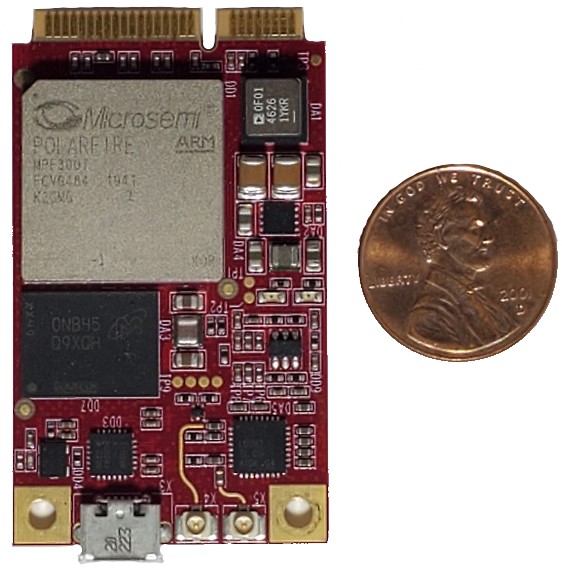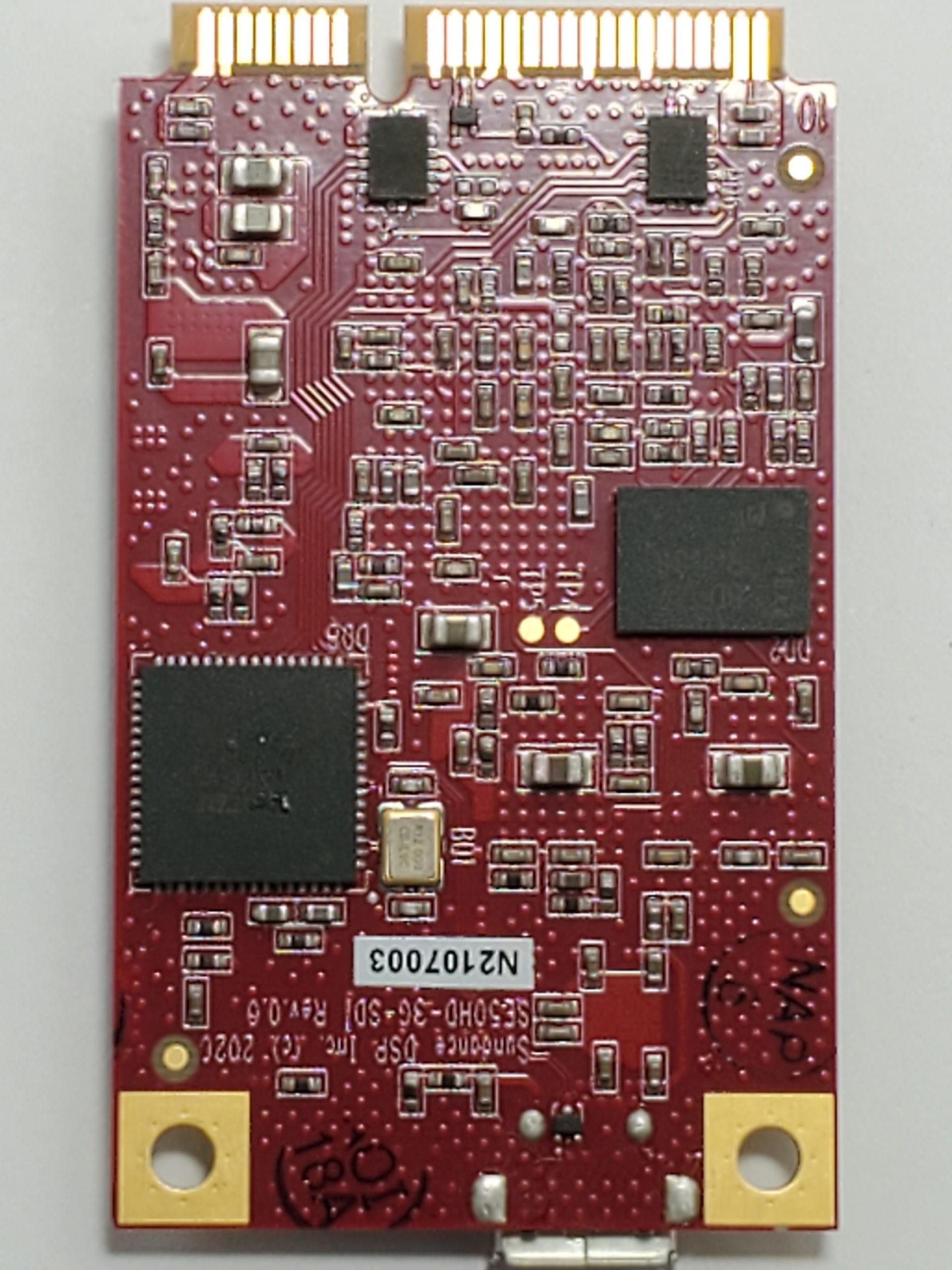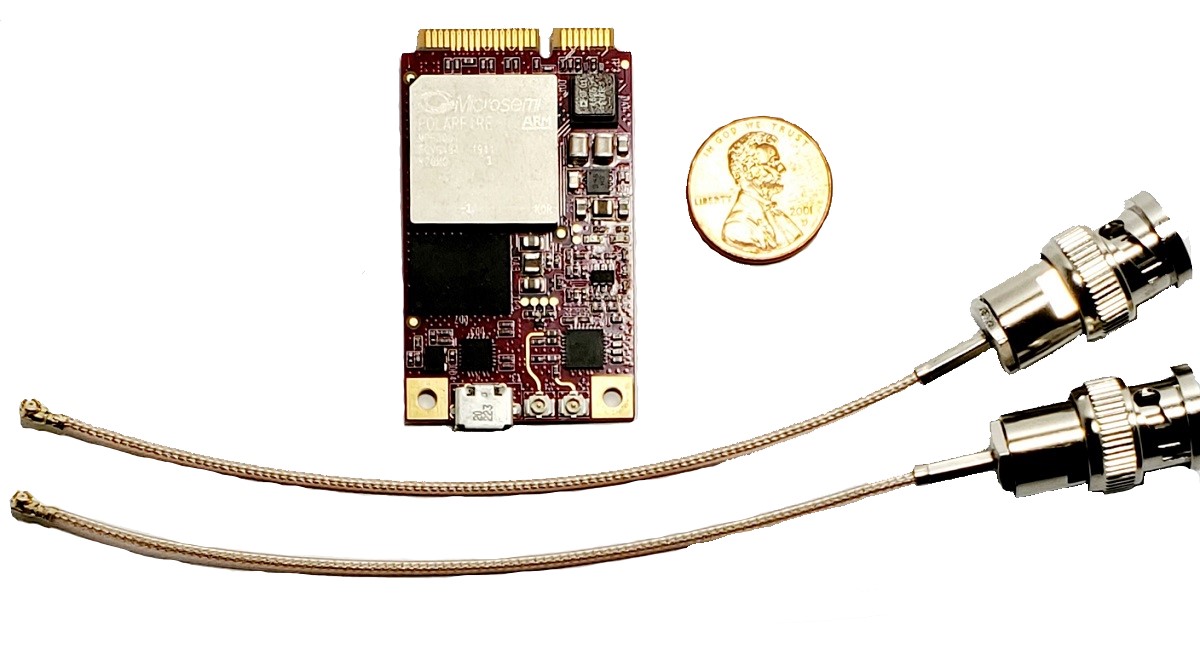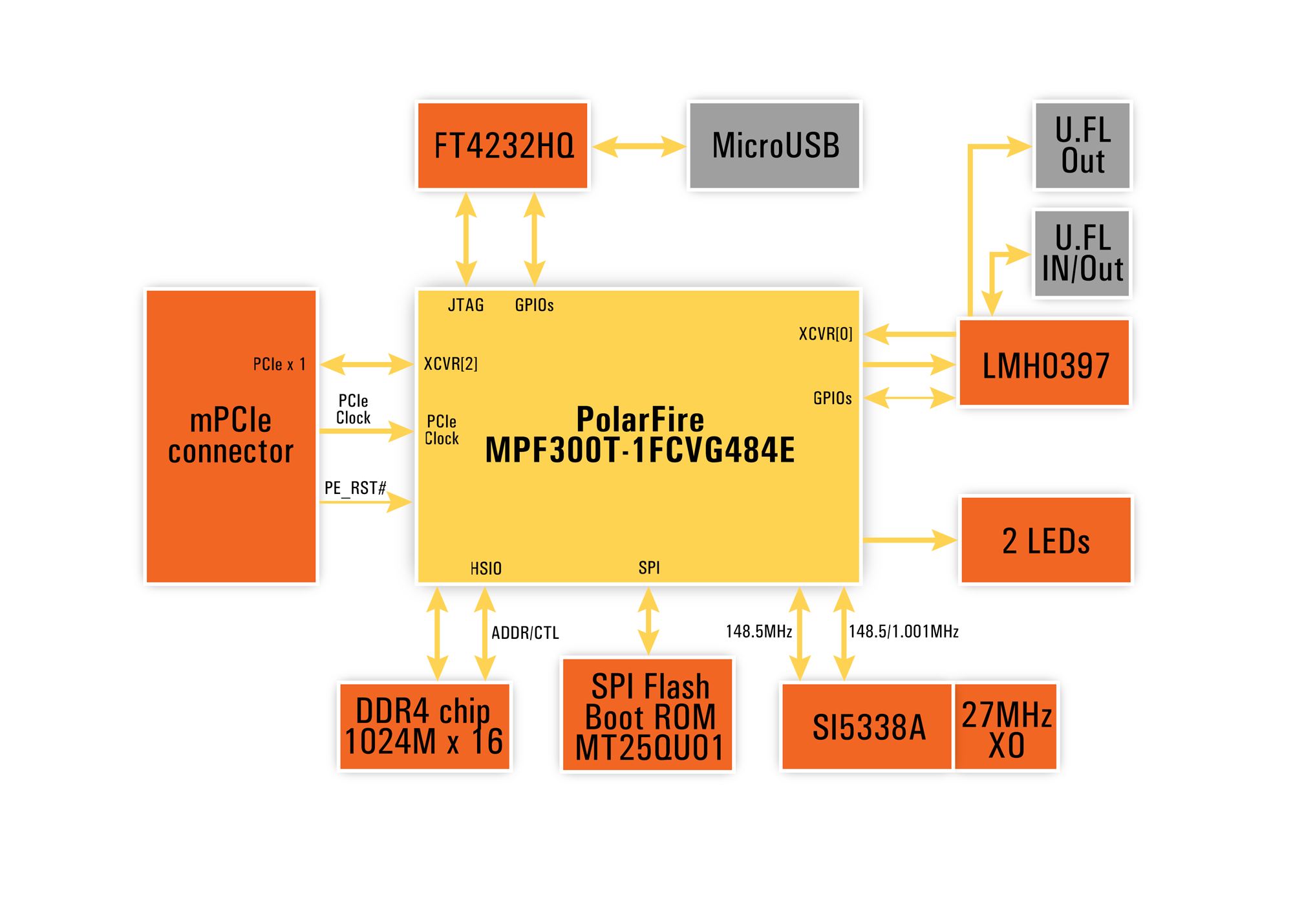Mini PCIe IO and processing module based on Microsemi PolarFire MPF300T-1FCVG484 FPGA
The SE50-3G-SDI is a small footprint mini-PCIe board with support for 3G/SDI videos. It uses PolarFire MPF300T-1FCVG484E FPGA for processing and to interface to the host. A TI LMH0397 chip is used for 3G/SDI functionality. It has 2 U.FL connectors which can be used as 2 Outputs or as one Input and one Output.
There is a complete BSP for supporting RedHat 7.9 or Ubuntu 20.04 for the host operating system. For detailed information, please contact the Sundance support team. Below is a short list of features and functions available as part of BSP:
- Support for 3G and SDI, RAW and Formatted modes
- Support for two modes of operation:
- Idle/Capture.
- Playback
- Ability to read from the host and send to output
- Ability to capture and write to the host and save to file
- Capture and send to output
- Supports Y C′bC′r 4:2:2 formats:
- 10bit: 1080p30, 720p60, 1080p60, 1080p25, 720p50, 1080p50;
- 12bit: 1080p30, 1080p25;
- Support of 30/1.001 & 60/1.001 variants;
- RGB 4:4:4 format: 10bit: 1080p24;
Features
- MPF300T-1FCVG484E PolarFire FPGA from Microchip
- LMH0397 3G-SDI 75-Ω bidirectional I/O with integrated re-clocker
- One 1024×16 DDR4 chip for RAM (2GB of DDR4) in 16-bit data-bus
- PCIe x1 Gen2 as EP
- 128Mbyte SPI chip for ROM
- A programmable clock generator based on SI5338A can generate any frequency
- Reference generator 27MHz±25ppm;
- One U.FL connector is used as a video input/output, second U.FL connector is used as a video output, or loopback output
- USB-JTAG/UART connector on the front panel
- Two user LEDs, Green and Red
- Temperature range, -40°C to +85°C;
- The maximum power consumption of the board is 10W
Applications
- Industrial Automation
- Control
- Defense
- imaging
SE50-3G/SDI includes the hardware, 2 cables, and the BSP firmware in binary form
SE50-3G/SDI-source includes the BSP with the firmware in source form
Standard firmware/software supports 3G/SDI formats. New enhancement includes V210 format.
V210 Video Format: What It Is and Why It Matters
The V210 video format is a popular 10-bit, YUV 4:2:2 color sampling format used primarily in professional video production and broadcast. It is especially favored in situations where high-quality video is essential, such as in post-production editing, broadcasting, and archival video storage.
V210 is a compressed format that allows for efficient storage of high-quality video while maintaining a superior visual experience. The format is particularly important because:
- High color depth: The 10-bit color depth allows for more accurate color representation, making it ideal for professional workflows where color grading and subtle color adjustments are critical.
- Efficient for broadcast and post-production: V210 is widely used in broadcasting, as it strikes an excellent balance between file size and image quality. It is often preferred when dealing with high-definition video footage that requires minimal compression for post-production workflows.
- Industry-standard: Many video processing systems, video servers, and editing platforms rely on V210 as an industry-standard format for capturing, storing, and transferring video content.
By adding support for V210, the SE50-3G/SDI firmware enables users to seamlessly convert their SDI video signals into this professional-grade format, ready for use in a variety of broadcast and post-production environments.
Firmware Enhancement: Real-Time Conversion to V210 Format
One of the standout features of the SE50-3G/SDI firmware update is the ability to convert SDI video signals into V210 formaton the fly.
Previously, the SE50-3G/SDI firmware supported two primary output modes:
- RAW output: In this mode, the raw SDI data is captured and transferred to the host system via Direct Memory Access (DMA), leaving it up to the host system to handle any further processing.
- Formatted output: The raw SDI data is processed into distinct blocks, including video frames and ancillary data packets, and is then transferred to the host.
With the latest firmware update, we’ve enhanced the board’s capabilities to automatically convert SDI video data into V210 format. This means that as video frames are captured via the SDI input, the firmware converts them into V210-compliant video frames, which are then packed and transferred to the host system via DMA.
This real-time conversion to V210 format simplifies the workflow for users, as they no longer need additional software or hardware to convert the SDI signals into a compatible format for video editing, storage, or transmission.
Why This Enhancement Matters
The addition of V210 support enhances the flexibility and performance of the SE50-3G/SDI device, making it a more powerful solution for:
- Broadcast professionals: Who require high-quality video capture and generation, particularly for SDI-based workflows.
- Post-production teams: Who rely on high-quality, minimal-latency video formats for editing and mastering content.
- System integrator: These build custom solutions for video capture and distribution in various applications, from studio setups to field deployments.
By enabling real-time conversion of SDI signals to the V210 format, the SE50-3G/SDI not only improves efficiency but also helps ensure that high-definition video content is captured and transmitted with maximum visual quality and minimal computational overhead.
Dual Capability as Both SDI Capture and Signal Generator
The SE50-3G/SDI is not just a video capture device; it can also function as a powerful SDI signal generator. When raw SDI signals are provided to the board (via DMA), it can generate corresponding SDI output. This dual capability is crucial for users who need to capture, modify, and then broadcast SDI signals in real time. With this feature, the SE50-3G/SDI transforms into a full-fledged video generator, enabling users to create and transmit professional-grade SDI signals with ease. Whether used in production environments for live broadcasts, or in testing and development scenarios, this small yet powerful board offers tremendous flexibility for creating high-quality video content on demand.
SE50-MPF100-1-E Mini-PCIe module with -1 speed grade MPF100T-1FCVG484E, JTAG interface, 4 GB of DDR4, and SPI FLASH.
SE50-MPF200-1-E Mini-PCIe module with -1 speed grade MPF200T-1FCVG484E, JTAG interface, 4 GB of DDR4, and SPI FLASH.
SE50-MPF300-1-E Mini-PCIe module with -1 speed grade MPF300T-1FCVG484E, JTAG interface, 4 GB of DDR4, and SPI FLASH.
The products listed above are chips with an extended temperature range; for the Industrial temperature range please order:
SE50-MPF100-1-I
SE50-MPF200-1-I
SE50-MPF300-1-I





